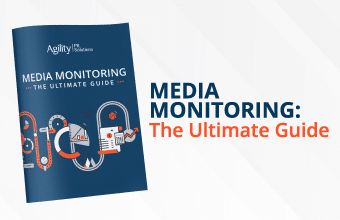Just as there’s no such thing as a perfect person, there’s no such thing as a perfect brand. As the experts at our recent Crisis Comms Mastery virtual summit warned, no one is crisis immune.
While that’s enough to keep any PR pro, comms professional, CEO, board member, or spokesperson up at night, the silver lining is that a strong communications-led offense is the best defense against threats to a brand’s reputation (and livelihood).
So, how can a PR and comms teams best prepare a brand for a crisis? It all starts with media monitoring.
With media monitoring, you’re actively listening to the conversation that’s happening about and around your brand. This becomes even more critical when an issue or crisis arises, as it will allow you to rapidly get a handle on the situation and prepare your response.
Here are five reasons why investing in a good media monitoring tool can help you combat a crisis:
1. Foresight to avoid a crisis
When approaching crisis management, it’s crucial for companies to plan for the worst. Envisioning a series of worst-case scenarios requires a good understanding of the internal and external threats facing your brand.
Media monitoring allows you to understand the outside forces that could pose a potential threat. By gaining knowledge of your audiences, industry, competitors, and other aspects of your environment, you’ll become aware of potential sources of conflict or sensitivities that may exist. Armed with this crucial knowledge, you’ll have what you need to tweak your messaging to avoid making an embarrassing misstep or alienating anyone.
2. Early crisis detection
PR professionals want (and need) to be the first to know when unsavory media coverage effects their brand, even if it’s only indirectly. Not only does the early warning give them a heads up and allow them to prepare a timely and effective response, it helps them save face internally. After all, no one wants to be informed by their CEO about a negative news mention they should have known about! Luckily, a comprehensive media monitoring program will catch the news quickly and alert the comms team to any signs of a crisis.
Regular use of a media monitoring tool provides your team a clear coverage baseline (volume, sentiment, topics). When something deviates from that baseline (such as a sudden influx of social mentions), it’s a good indication that a crisis could be budding.
Video: Media Monitoring & Crisis Management
3. Guiding a crisis response
Before responding to a crisis, PR pros need to know as much as possible about the situation, including what is being said and by whom. This can mean the difference between an effective, well-received response and one that simply fans the flames or worse, damages the brand’s reputation more.
You can’t respond effectively to a crisis if you don’t fully understand the sentiment of your audience. To prepare a statement and develop remedial actions that aren’t perceived as tone-deaf, a PR professional needs to ensure they address the public’s concerns and correct any damaging misinformation that may be circulating.
Similarly, media monitoring will help you determine the general attitude about your brand’s role in the crisis and where your brand’s actions may have deviated from your audience’s values. Once you identify the gap, your response should realign brand actions with public values to avoid further damaging your company’s reputation or inhibiting your future ability to do business.
Finally, monitoring is essential in evaluating your response to the crisis, how it was perceived, and if more needs to be done to combat concerns.
4. Understanding the progression of a crisis
Keeping tabs on a crisis as it progresses is essential. Regular updates will keep your crisis team and stakeholders informed about how your brand is being perceived and whether coverage is ramping up or beginning to die down.
A robust media monitoring program will help you compare your company’s pre-crisis public image with its post-crisis public image, so you can better gauge how to focus your rehab efforts and determine when you’re back on track.
Making effective use of a monitoring tool’s reporting capabilities allows PR pros to showcase the tangible results of their crisis management efforts.
5. Finding opportunities in a crisis
In the short-term, you want to respond to a crisis so effectively that the story doesn’t last long. But a brand must also consider the long-term implications of a crisis to restore its reputation and to grow and become a stronger brand overall. Analyze the coverage your media monitoring tool collected, focusing on how people thought you handled the crisis, whether your response was perceived as authentic, and any ongoing concerns from the public. Evaluation of lessons learned is key to becoming a more resilient brand.
For PR pros that don’t already have a formal monitoring program in place, keep in mind that it’s never too late to begin. A top-rated media monitoring solution, backed by an incredible support team, is a powerful tool to help you combat your next crisis.








